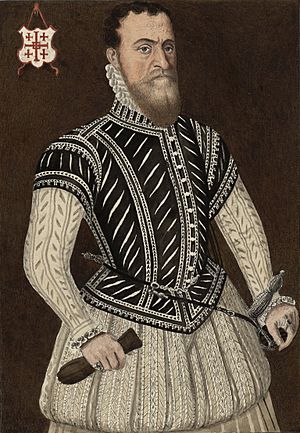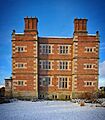Richard Clough facts for kids
Sir Richard Clough (born around 1530, died 1570) was a very important merchant from Denbigh, a town in north-east Wales. People in Wales at the time knew him as Rhisiart Clwch. He also worked as an agent for Queen Elizabeth I of England, helping her with important tasks.
Contents
Early Life and Big Adventures
Richard Clough came from a simple family. But he was very talented! When he was a boy, he sang in the choir at Chester Cathedral. His singing was so good that people noticed him and helped him move to London.
He traveled a lot and even visited Jerusalem. Because of this trip, he became a special knight called a Knight of the Holy Sepulchre. When he returned to London, he started working for a famous merchant named Thomas Gresham. Richard became a "factor" for Gresham, which means he was like a manager for his business. He also joined the Mercers' Company, a group for merchants.
A Busy Trader in Antwerp
In 1552, Richard Clough moved to Antwerp. At that time, Antwerp was a huge center for trade and banking in Northern Europe. It was like a very busy financial hub! While there, he met and married Catherine Muldart, who was from Antwerp. They had a son named Richard.
In 1558, he wrote about a big ceremony he saw in Brussels for Emperor Charles V. Later, in 1561, he had a great idea. He wrote to his boss, Thomas Gresham, suggesting that London should have a place like Antwerp's "Bourse" – a special building where merchants could meet to trade. Gresham loved the idea! He went on to create the Royal Exchange in London, which opened in 1571. Richard Clough helped a lot with this project. He helped get money for it and even found the Flemish architect Hendrik van Passe to design the building.
Richard wrote many long letters. These letters were so full of useful information that Gresham often passed them on to the government. Historians still use them today to learn about the past! For example, he wrote an amazing eyewitness account of a big event in Antwerp in 1566 called the "Iconoclastic Fury" or Beeldenstorm. He described how people broke and destroyed everything inside churches. He said the Church of Our Lady in Antwerp "looked like a hell, with above 10,000 torches burning, and such a noise as if heaven and earth had got together." He saw "falling of images and beating down of costly works." It was a truly wild scene!
Coming Home to Wales
Richard Clough returned to Wales in 1565. He was very rich by then! He brought new building styles from Flanders (a region in Europe) to Wales. He built two houses: Bach-y-graig and Plas Clough. People in his home area even started using his name as a way to say someone was very wealthy! He also planned to make the River Clwyd easier for boats to travel on.
Richard was also interested in astronomy (studying stars and planets). He supported Humphrey Llwyd, a mapmaker from Denbigh, and was friends with another famous mapmaker, Ortelius.
In 1567, he was given an important job as "court master" for a group of merchants called the London Merchant Adventures. He died unexpectedly in Hamburg, Germany, sometime between March and July of 1570. He was getting ready to bring his second wife, Katheryn of Berain, back home to the new house he had built for her at Plas Clough, near Denbigh.
There's a local folk tale in Tremeirchion about Richard Clough. The story says that he was carried away by the Devil and never seen again! This supposedly happened after his wife found him talking about alchemy and other "godless" topics in the house he built for her.
Flemish Style in Welsh Houses
When Sir Richard Clough built Bach-y-graig in Tremeirchion and Plas Clough, he brought new ideas from the Renaissance period to north-east Wales. These were the first brick houses in Wales! They were built in the style he saw in Antwerp, and Flemish (Belgian) builders helped construct them.
One special feature of these houses was the "crow-stepped gable," which looks like steps on the top edge of the roof. This was a common style in Flemish architecture. Many other grand houses built in north Wales at that time copied this style, like Plas Mawr in Conwy and Faenol Fawr near St Asaph. Another interesting feature at Bach-y-graig was having many dormer windows (windows that stick out from a sloping roof). The Myddelton Arms in Ruthin, which also belonged to Clough, had three rows of these dormer windows!
Images for kids






